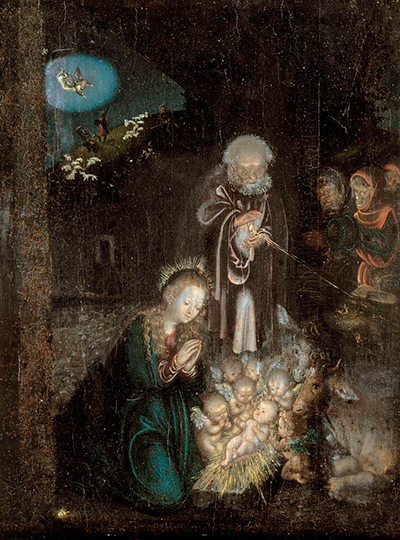The Adoration of the Shepherds is a circa 1515-1520 oil painting by the German painter Lucas Cranach the Elder. The art was once part of the collection of Richard von Kaufman.
In 1917, the museum purchased it from his property and was later claimed by the Russians in 1945. Ten years later, in 1955, the painting was returned to the museum. This painting depicts a scene of nocturnal events in which Mary succumbed to Christ in prayer, while Joseph stood over them with a candle, but the primary source of light came from the cradle. Christ, who is in the form of a child, is surrounded by winged angels as he lies on the bed of hay that is blending with his mother's halo. The upper left corner of the frame shows the landscape under the moonlight. This shows the Annunciation to the three shepherds with Angel Gabriel as the moon. The portrait shows the three shepherds looking at the Holy family while standing behind a fence on the right side of the portrait.
The Adoration of the Shepherds painting consists of four parts. The bottom half is the worldly man – and the little boy Jesus, right in the middle. He connects heaven to earth. Jesus, Joseph, and Mary are separate units located at the center. There are shepherds in the upper left corner of the top half, with an angel appearing to them out on the field. This portrait was painted when Martin Luther first spoke of the light of the gospel and used candles as inspiration. To effectively translate the Bible and spread his message, he hired Cranach to produce illustrations.
Lucas Cranach the Younger, was a follower of his father and often described clothing and accessories in his paintings. After his father died in the mid-1530s, Cranach began to play an increasingly important role in his father's workshop. Although Lucas the Younger was successful, like his father, he did not make artistic achievements. Owing to his father's style, the ownership of some of Lucas Cranach the Younger's work was problematic such as The Fountain of Youth. Many art historians consider his work less spontaneous and emotional than that of his father. His best practices include simplified versions of stories, portraits and mythological scenes.




